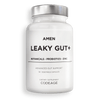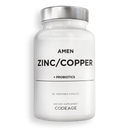- Amen Zinc Copper supplement delivers 50mg of zinc picolinate and copper glycinate chelate, providing a balanced blend of two essential minerals.
- Each capsule also includes 2 billion CFUs of probiotics to complement the mineral blend.
- This zinc picolinate supplement is easy to incorporate into your daily routine with just one capsule per serving. Each bottle provides a 3-month supply.
- The formula is vegan, non-GMO, and free from dairy, soy, and gluten. It is also Paleo and Keto-friendly.
- Amen Zinc Copper supplement is manufactured in the USA with globally sourced ingredients in a cGMP-certified facility for quality and purity.
Amen Zinc Copper With Probiotics.
Amen Zinc Copper supplement offers a blend of 50mg of zinc picolinate and copper glycinate chelate, combined with probiotics. This formula is convenient to use, with just one capsule per serving. Each bottle offers 3-month of supply.
- Amen Zinc Copper supplement delivers 50mg of zinc picolinate and copper glycinate chelate, providing a balanced blend of two essential minerals.
- Each capsule also includes 2 billion CFUs of probiotics to complement the mineral blend.
- This zinc picolinate supplement is easy to incorporate into your daily routine with just one capsule per serving. Each bottle provides a 3-month supply.
- The formula is vegan, non-GMO, and free from dairy, soy, and gluten. It is also Paleo and Keto-friendly.
- Amen Zinc Copper supplement is manufactured in the USA with globally sourced ingredients in a cGMP-certified facility for quality and purity.
Similar item to consider

Amen Leaky Gut+
$23.99Amen Zinc Copper supplement offers a blend of 50mg of zinc picolinate and copper glycinate chelate, combined with probiotics. This formula is convenient to use, with just one capsule per serving. Each bottle offers 3-month of supply.
Supplement Facts

Ingredients
Zinc (as Zinc Picolinate), Copper (as Glycinate Chelate), B. subtilis (2 Billion CFU). Other Ingredients: Methylcellulose Capsule.
Similar item to consider

Amen Leaky Gut+
$23.99EXPLORE MORE.
PRODUCT GALLERY.





Product Details
Supplement Facts

Ingredients
Zinc (as Zinc Picolinate), Copper (as Glycinate Chelate), B. subtilis (2 Billion CFU). Other Ingredients: Methylcellulose Capsule.
Suggested Use
Take 1 capsule daily with 8 ounces of water or your favorite beverage. May be taken with or without food.
CAUTION: Do not exceed recommended dose. Please use caution if you have allergies or sensitivities to any of the listed ingredients. Pregnant or nursing mothers and individuals with a known medical condition should consult a physician before using this or any dietary supplement. Use only as directed. If gastrointestinal discomfort (including bloating, cramps, diarrhea, or other digestive upset) or other sensitivity is experienced stop taking the product immediately. If you are pregnant, nursing, or have a medical condition, please consult with your physician before use. If you have any questions about consuming this dietary supplement, consult with your health care professional before using. If you use prescription drugs or over-the-counter medications, are unaware of your current medical condition or have a pre-existing medical condition(s), consult with your health care professional before using. Discontinue use immediately if you experience any adverse symptoms or reactions while taking this product. Discontinue use 2 weeks prior to surgery. Do not use if your health status is unknown. Do not use if safety seal is damaged or missing. Keep out of reach of children and pets. Store in a cool, dry place, away from heat moisture. Use this product as a food supplement only. Do not use for weight reduction.
EXPLORE MORE.

Zinc copper
harmony.
Amen Zinc Copper combines 50mg of zinc picolinate and copper glycinate chelate with 2 billion CFUs* of probiotics in a convenient daily capsule. This non-GMO formula offers a 3-month supply.
SUGGESTED USE.
Take 1 capsule daily with 8 ounces of water or your favorite beverage. May be taken with or without food.
CAUTION: Do not exceed recommended dose. Please use caution if you have allergies or sensitivities to any of the listed ingredients. Pregnant or nursing mothers and individuals with a known medical condition should consult a physician before using this or any dietary supplement. Use only as directed. If gastrointestinal discomfort (including bloating, cramps, diarrhea, or other digestive upset) or other sensitivity is experienced stop taking the product immediately. If you are pregnant, nursing, or have a medical condition, please consult with your physician before use. If you have any questions about consuming this dietary supplement, consult with your health care professional before using. If you use prescription drugs or over-the-counter medications, are unaware of your current medical condition or have a pre-existing medical condition(s), consult with your health care professional before using. Discontinue use immediately if you experience any adverse symptoms or reactions while taking this product. Discontinue use 2 weeks prior to surgery. Do not use if your health status is unknown. Do not use if safety seal is damaged or missing. Keep out of reach of children and pets. Store in a cool, dry place, away from heat moisture. Use this product as a food supplement only. Do not use for weight reduction.




































































